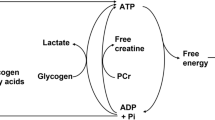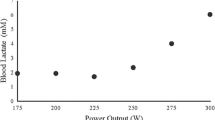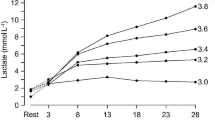Summary
A mathematical model of lactate kinetics after exercise has been constructed from the application of the mass conservation law and the following assumptions:
-
1.
The total lactate distribution space is composed of two compartments, i.e., (M) the previously working muscles and (S) the remaining lactate space;
-
2.
The rates of lactate release and utilization in (M) and (S) are proportional to the lactate contents of these compartments;
-
3.
The post-exercise lactate production rates in (M) and (S) are constants;
-
4.
Arterial lactate concentration can represent the average lactate concentration in (S).
Consideration of experimental facts reported in the literature shows these assumptions to be reasonable. The relationships obtained express the compatibility of parameters and time functions concerning lactate concentrations, as well as rates of production, uptake, release, and utilization. They open the way to various applications, especially those involving numerical fits to observed time courses of lactate concentrations.
Similar content being viewed by others
Abbreviations
- α12, α21 :
-
Coefficients denoting efficiency in lactate transfer from (M) to (S) and (S) to (M), respectively (min−1)
- a, a 0 :
-
Coefficients of linear fits to observed lactate removal rates
- b 0, b 1, b 2 :
-
Coefficients of linear fits to observed lactate releases
- (BS):
-
Blood space
- c 2, d 2 :
-
Coefficients denoting efficiency in lactate utilization by (M) and (S) (min−1)
- C 1, C 2 :
-
Amplitudes of the exponential terms of L M (t) (mmol·l−1)
- D 1, D 2 :
-
Amplitudes of the exponential terms of L s (t) (mmol·l−1)
- L :
-
Lactate concentration (mmol·l−1)
- L a (t):
-
Lactate concentration in arterial blood at time t obtained by fits to experimental data (mmol·l−1)
- L M (t), L S (t):
-
Lactate concentrations in (M) and (S) at time t (mmol·l−1)
- (LU), (LR):
-
Lactate uptake and lactate release rates (mmol·l−1)
- (LU) M , (LR) M :
-
Simultaneous muscular lactate uptake and lactate release rates (mmol·min−1)
- L V (t):
-
Lactate concentration in blood leaving (M) at time t (mmol·l−1)
- (M), (S):
-
Worked muscle space and remaining lactate space
- (MRR):
-
Metabolic removal rate of lactate (mmol·min−1)
- (PR):
-
Lactate production rate (mmol·min−1)
- (PR) M =c 1; (PR) S =d 1 :
-
Lactate production rates in (M) and (S), respectively (mmol·min−1)
- q (t):
-
Blood flow perfusing (M) at time t (l·min−1)
- (REX):
-
Rate of lactate excretion (mmol·min−1)
- r 1, r 2 :
-
Roots of the characteristic equation (min−1)
- t :
-
Time after the end of exercise (min)
- (TLS):
-
Total lactate distribution space
- V :
-
Volume of a compartment (1)
- V M , V S :
-
Volumes of (M) and (S) (1)
- V MS :
-
V M to V S ratio
- V SM :
-
V S to V M ratio
- γ 1, γ 2 :
-
Theoretical velocity constants of the time functions (min−1)
- Φ mM (t), Φ mS (t):
-
Lactate utilization rates in (M) and (S) (mmol·min−1)
- Φ MS (t):
-
Net muscular release rate of lactate (mmol·min−1)
- Μ :
-
Net muscular release rate of lactate at t→∞ (mmol·min−1)
References
Ahlborg G, Felig P (1977) Substrate utilization during prolonged exercise preceded by ingestion of glucose. Am J Physiol 233: E188-E194
Belcastro AN, Bonen A (1975) Lactic acid removal rates during controlled and uncontrolled recovery exercise. J Appl Physiol 39: 932–936
Bergström J, Guarnieri G, Hultman E (1971) Carbohydrate metabolism and electrolyte changes in human muscle tissue during heavy work. J Appl Physiol 30: 122–125
Bonen A, Campbell CJ, Kirby RL, Belcastro AN (1979) A multiple regression model for blood lactate removal in man. Pflügers Arch 380: 205–210
De Coster A, Denolin H, Messin R, Degre S, Vandermotten P (1969) Role of the metabolites in the acid-base balance during exercise. In: Poortmans JR (ed) Biochemistry of exercise. Karger, Basel New York, pp 15–34
Depocas B, Minaire Y, Chatonnet J (1969) Rates of formation and oxidation of lactic acid in dogs at rest and during moderate exercise. Canad J Physiol Pharmacol 47: 603–610
Eldridge FL, T'so L, Chang H (1974) Relationship between turnover rate and blood concentration of lactate in normal dogs. J Appl Physiol 37: 316–320
Eldridge FL (1975) Relationship between turnover rate and blood concentration of lactate in exercising dogs. J Appl Physiol 39: 231–234
Freund H, Gendry P (1978) Lactate kinetics after short strenuous exercise in man. Eur J Appl Physiol 39: 123–135
Freund H, Zouloumian P (1981) Lactate after exercise in man: I. Evolution kinetics in arterial blood. Eur J Appl Physiol 46: 121–133
Freyschuss U, Strandell T (1967) Limb circulation during arm and leg exercise in supine position. J Appl Physiol 23: 163–170
Graham TE, Sinclair DG, Chapler CK (1976) Metabolic intermediates and lactate diffusion in active dog skeletal muscle. Am J Physiol 231: 766–771
Hermansen L, Stensvold I (1972) Production and removal of lactate during exercise in man. Acta Physiol Scand 86: 191–201
Hermansen L, Maehlum S, Pruett EDR, Vaage O, Waldum H, Wessel-Aas T (1975) Lactate removal at rest and during exercise. In: Howald H, Poortmans JR (eds) Metabolic adaptations to physical exercise. BirkhÄuser, Basel, pp 101–105
Hermansen L, Vaage O (1977) Lactate disappearance and glycogen synthesis in human muscle after maximal exercise. Am J Physiol 233: E422-E429
Hirche H, Wacker U, Langohr HD (1971) Lactic acid formation in the working gastrocnemius of the dog. Int Z Angew Physiol 30: 52–64
Holmgren A (1959) Arterio-venous lactic acid differences in man at rest and during muscular work. Scand J Clin Lab Invest 11: 150–153
Issekutz B Jr, Shaw WAS, Issekutz AC (1976) Lactate metabolism in resting and exercising dogs. J Appl Physiol 40: 312–319
Jorfeldt L (1970) Metabolism of L(+) — Lactate in human skeletal muscle during exercise. Acta Physiol Scand 78: [Suppl] 338
Jorfeldt L, Dannfeldt AJ, Karlsson J (1978) Lactate release in relation to tissue lactate in human skeletal muscle during exercise. J Appl Physiol 44: 350–352
Karlsson J (1971) Lactate and phosphagen concentrations in working muscle of man. Acta Physiol Scand 81: [Suppl] 358
Knuttgen HG, Saltin B (1972) Muscle metabolites and oxygen uptake in short-term submaximal exercise in man. J Appl Physiol 32: 690–694
McGrail JC, Bonen A, Belcastro AN (1978) Dependence of lactate removal on muscle metabolism in man. Eur J Appl Physiol 39: 89–97
Minaire Y, Pernod A, Jomain MJ, Mottaz M (1971) Lactate turnover and oxidation in normal and adrenal-demedullated dogs during cold exposure. Can J Physiol Pharmacol 49: 1063–1070
Mitchell AM, Cournand A (1955) The fate of circulating lactic acid in the human lung. J Clin Invest 34: 471–476
Olsen C, Strange Petersen E (1973) The lactate/pyruvate ratio in muscular work and following injection of lactate in man. Pflügers Arch 342: 359–365
Rowell LB, Kraning II KK, Evans TO, Kennedy JW, Blackmon JR, Kusumi F (1966) Splanchnic removal of lactate and pyruvate during prolonged exercise in man. J Appl Physiol 21: 1773–1783
Sahlin K, Harris RC, Nylind B, Hultman E (1976) Lactate content and pH in muscle samples obtained after dynamic exercise. Pflügers Arch 367: 143–149
Zouloumian P, Freund H (1981) Lactate after exercise in man: III. Properties of the compartment model. Eur J Appl Physiol 46: 149–160
Author information
Authors and Affiliations
Rights and permissions
About this article
Cite this article
Zouloumian, P., Freund, H. Lactate after exercise in man: II. Mathematical model. Europ. J. Appl. Physiol. 46, 135–147 (1981). https://doi.org/10.1007/BF00428866
Accepted:
Issue Date:
DOI: https://doi.org/10.1007/BF00428866




